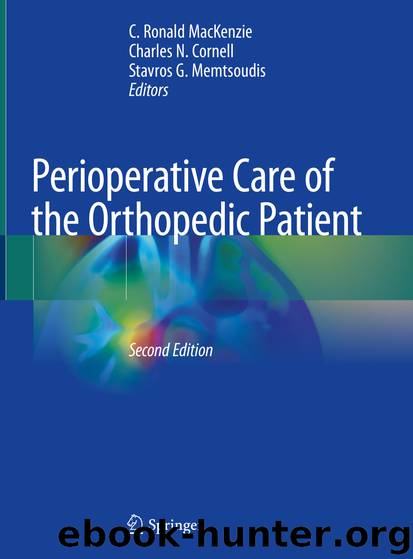Perioperative Care of the Orthopedic Patient by Unknown

Author:Unknown
Language: eng
Format: epub
ISBN: 9783030355708
Publisher: Springer International Publishing
Peripheral Nerve Injury
Leg weakness after hip or knee surgery is a common cause for neurological consultation in the postoperative setting. Weakness of the ankle (foot drop) is a common complaint or finding. Foot drop is associated with a variety of surgical procedures, including cervical and lumbar spine surgery [30] as well as knee [31] and hip [32] replacement. Simply having surgery is thought to be a rare cause of an autoimmune inflammatory neuropathy [33].
Foot drop occurs most often after hip surgery with a prevalence of 0.17–1.9% of patients undergoing total hip arthroplasty (THA) [34, 35]. The nerves affected include the sciatic (71–100%), femoral (0–20%), and obturator (rare but one series reported 7% involvement). When the sciatic nerve is involved, the peroneal division is most often affected [36]. Risk factors include revision surgery [34], coexisting lumbar spinal stenosis [37], preexisting peripheral neuropathy, younger age, and smoking. Femoral neuropathy also occurs after THA. The incidence after primary THA is 0.1–2.4% and it is higher after revision procedures (0.3–3%) [38]. It may also occur after hip arthroscopy. Causes include iatrogenic/mechanical factors (trauma, cement, heat) [39], hip dysplasia [37], difficulty of the surgery and positioning, leg lengthening, surgical approach (anterior) [40], and compression from hematoma [41–43]. The reason why neuropathy occurs more often after revisions is uncertain but it may be related to the more extensive dissection through scar tissue required in these procedures as well as possible tethering of the nerve by scar tissue. Obturator and superior gluteal nerve injuries rarely occur in association with THA but have been reported. Gluteal nerve injuries may occur in association with the direct lateral approach. Obturator nerve injuries are often undiagnosed and cause inguinal or groin pain.
Nerve injuries after total knee arthroplasty (TKA) are also rare (0.3–1.3%). Risk factors include preoperative valgus deformity, postoperative epidural anesthesia, rheumatoid arthritis, preexisting neuropathy, use of tourniquet, and hematoma formation at the wound site [44]. Patients usually have weakness immediately after surgery, although the weakness can be delayed by a day or two due to possible injury from edema or masking by peripheral nerve blocks. The peronal division of the sciatic nerve or the common peroneal nerve is the most common nerve affected. This typically causes a foot drop and numbness or neuropathic pain in the lateral lower leg and dorsum of the foot. The reason why the peroneal division is more affected than the tibial division is not known. There are a few proposed mechanisms including less connective tissue in the peroneal nerve making it more prone to traction injuries, the relatively fixed nature of the peroneal nerve at the sciatic notch, and the natural course of the nerve being superficial and more lateral than the tibial nerve. Nevertheless, muscles innervated by the tibial nerve are often affected to a lesser extent [45]. Femoral and obturator nerve dysfunction occur in 0.1–2.4% of cases and are often detected slightly later in the postoperative period as the subjective awareness of problems with knee movement may not be realized until the patient resumes mobility [35, 46].
Download
This site does not store any files on its server. We only index and link to content provided by other sites. Please contact the content providers to delete copyright contents if any and email us, we'll remove relevant links or contents immediately.
Navigation and Map Reading by K Andrew(5111)
Spare by Prince Harry The Duke of Sussex(5072)
Tuesdays with Morrie by Mitch Albom(4692)
Cracking the GRE Premium Edition with 6 Practice Tests, 2015 (Graduate School Test Preparation) by Princeton Review(4224)
Machine Learning at Scale with H2O by Gregory Keys | David Whiting(4179)
Never by Ken Follett(3790)
Goodbye Paradise(3728)
What It Really Takes to Get Into Ivy League and Other Highly Selective Colleges by Hughes Chuck(3696)
Harry Potter and the Prisoner of Azkaban (Book 3) by J. K. Rowling(3304)
Fairy Tale by Stephen King(3220)
Pledged by Alexandra Robbins(3132)
Kick Ass in College: Highest Rated "How to Study in College" Book | 77 Ninja Study Skills Tips and Career Strategies | Motivational for College Students: A Guerrilla Guide to College Success by Fox Gunnar(3075)
A Dictionary of Sociology by Unknown(3031)
Sapiens and Homo Deus by Yuval Noah Harari(2987)
Reminders of Him: A Novel by Colleen Hoover(2951)
The Social Psychology of Inequality by Unknown(2940)
Graduate Admissions Essays, Fourth Edition: Write Your Way into the Graduate School of Your Choice (Graduate Admissions Essays: Write Your Way Into the) by Asher Donald(2876)
Will by Will Smith(2793)
Zero to Make by David Lang(2726)
